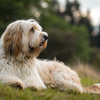Why Do Dogs Like to Roll in Grass? Understanding This Fascinating Behavior
- Houndsy
Table of Contents
- Introduction
- The Instinctual Roots of Rolling in Grass
- Comfort and Cooling Off
- The Sensory Experience of Rolling in Grass
- Social Context of Rolling in Grass
- Should You Allow Your Dog to Roll in Grass?
- Conclusion
- FAQ
Introduction
Have you ever watched your dog joyfully roll in the grass, seemingly lost in the moment, and wondered what on earth they were thinking? You're not alone. This behavior is not just amusing to witness; it's deeply rooted in canine instincts and can be quite complex. In fact, studies show that dogs have around 300 million olfactory receptors in their noses, compared to a human's five million. This incredible sense of smell plays a significant role in why dogs engage in behaviors like rolling in grass.
In this blog post, we will explore the various reasons why dogs like to roll in grass. By the end, you'll have a comprehensive understanding of this natural behavior, and we hope you’ll feel more connected to your furry friend. We’ll delve into instinctual drives, sensory enjoyment, and even the social aspects of this behavior, offering insights that can enhance your daily interactions with your canine companion.
So, why do dogs like to roll in grass? Let’s uncover the reasons behind this delightful behavior and what it means for your dog!
The Instinctual Roots of Rolling in Grass
Scent Marking and Camouflage
Dogs are descendants of wolves, and many of their behaviors can be traced back to their wild ancestors. One of the primary instincts that drives dogs to roll in grass is the need to mask their scent. In the wild, covering their own scent with the odors of their environment would have made it easier for wolves to hunt prey without being detected. When your dog rolls in the grass—or in something particularly smelly—they may be instinctively trying to camouflage themselves.
This behavior can also serve as a way for dogs to leave their own scent behind. When they roll in a specific spot, they not only pick up the scents of other animals but also deposit their own scent through their skin and fur, marking their territory or communicating with other dogs.
Communication with Other Dogs
Dogs are social creatures that communicate largely through scent. When a dog rolls in grass, they may be trying to share information or engage in a form of social interaction. The grassy area could contain scents left by other dogs, and rolling in those scents allows your dog to "send a message" to others that they have been there. This is akin to a human leaving a note for a friend—an olfactory postcard, if you will.
Natural Behavior and Playfulness
Rolling in grass can also simply be a manifestation of playfulness. Dogs, especially younger ones, often engage in playful behaviors that include rolling, jumping, and running around. The texture of grass can feel good against their fur and skin, providing a natural form of a back scratch or massage. Imagine coming home after a long day and collapsing onto a soft bed—dogs feel similarly when they roll in grass.
Comfort and Cooling Off
A Natural Back Scratch
Just like humans sometimes scratch an itch, dogs use rolling as a way to relieve discomfort. If a dog has an itch they can't quite reach, rolling in the grass provides a natural solution. The grass acts as a gentle exfoliant, helping to relieve irritation and promote circulation.
Cooling Down on a Hot Day
On hot days, rolling in grass can also serve a functional purpose: cooling down. Grass holds moisture, and as dogs roll around, the moisture can help regulate their body temperature. Unlike humans, dogs primarily cool down through panting, but rolling in cool grass can provide additional relief on hot summer days.
The Sensory Experience of Rolling in Grass
Enjoying the Scents of Nature
Dogs experience the world primarily through their sense of smell. When they roll in grass, they are likely engaging with a rich tapestry of scents, from flowers and plants to other animals. The sensory experience can be akin to a human enjoying a beautiful landscape or an exciting meal. For dogs, rolling in grass is a form of exploration and enjoyment that stimulates their senses.
The Appeal of "Gross" Smells
It’s no secret that dogs are attracted to smells that humans might find unpleasant, like animal feces or decomposing matter. This behavior is instinctive and can be traced back to their ancestors, who would roll in such substances to hide their scent while hunting. Allowing your dog to engage with these smells is a natural part of their exploration but can be a challenge for pet owners when it comes to bath time!
Social Context of Rolling in Grass
Observational Learning from Other Dogs
Dogs are keen observers and often learn behaviors from one another. If your dog sees another dog rolling in the grass, they may imitate this behavior out of curiosity or a desire to interact. Rolling in grass can also be a part of a play routine, where dogs engage in friendly competition or simply enjoy each other's company.
Expressing Joy and Happiness
Another reason dogs might roll in grass is to express joy. You may notice your dog performing this behavior after a bath or grooming session, as they may be trying to rid themselves of the scents of shampoo or conditioner. Rolling around can be a way of saying, "I'm back to being me!"
Should You Allow Your Dog to Roll in Grass?
When to Let Them Roll
Generally speaking, rolling in grass is a normal and healthy behavior for dogs. If your dog appears happy, relaxed, and engaged while rolling, there’s no reason to discourage it. Allowing them to express this natural behavior can enhance their overall well-being.
When to Redirect the Behavior
However, there are times when you might want to redirect your dog's rolling behavior. If they are rolling in something particularly unsanitary—like feces or dead animals—it’s a good idea to discourage this behavior for health and hygiene reasons. Instead, you can redirect their attention to a toy or engage them in play. Positive reinforcement training can be invaluable here; rewarding them for choosing a more acceptable behavior can help them learn.
Conclusion
Understanding why dogs like to roll in grass enriches our connection with our furry companions. This behavior is deeply rooted in instinct, scent communication, and physical comfort. Whether your dog is trying to mask their scent, enjoy the sensory experience, or simply have a blast, rolling in grass is a natural part of their behavior.
As pet owners, the best we can do is embrace these quirks and find joy in our dogs' unique personalities. We hope this exploration of canine behavior has given you insight into your dog's antics, making your time together even more enjoyable.
If you’re looking to enhance your daily routine and make feeding time easier, consider exploring our flagship product, the Houndsy Kibble Dispenser. With its ergonomic design, perfect portion control, and stylish aesthetic, it simplifies and elevates your dog's feeding ritual.
FAQ
1. Is it normal for dogs to roll in grass?
Yes, it is completely normal for dogs to roll in grass. It serves multiple purposes, including scent marking, communication, and simply expressing joy.
2. Should I stop my dog from rolling in grass?
Generally, you should allow your dog to roll in grass unless they are rolling in something unsanitary. In such cases, redirect their attention to a more acceptable behavior.
3. Why do dogs roll in grass after a bath?
Dogs often roll in grass after a bath to rid themselves of the scents of grooming products, returning to their natural smell.
4. Can rolling in grass be harmful to my dog?
While rolling in clean grass is safe, be cautious of areas treated with pesticides or herbicides, as these can be harmful to dogs.
5. How can I prevent my dog from rolling in unpleasant substances?
Training your dog to respond to commands and using positive reinforcement can help redirect their behavior when they attempt to roll in undesirable items.









